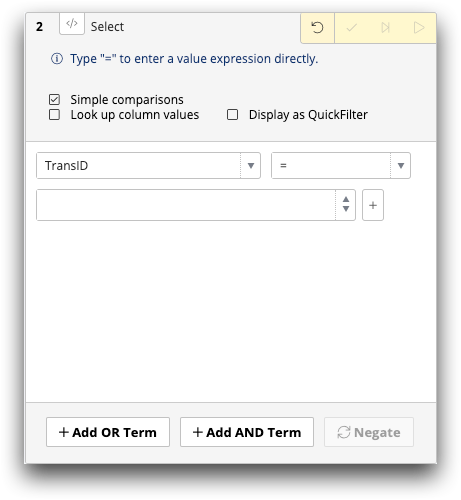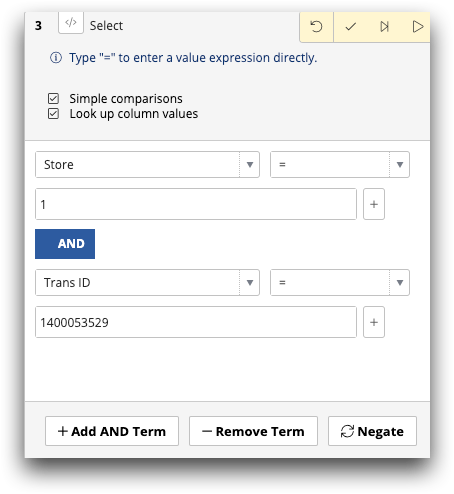Use simple comparisons to select rows
Row selection allows you to focus on a subset of rows.
To use simple comparisons to select rows:
-
Open the Select panel by doing one of the following:
- In the New operation panel, click Select.
- In the grid, right-click a cell within the column on which you want to base the selection and click Select on [COLUMN_LABEL].
Note: In this topic, [COLUMN_LABEL] represents the label of the column in which the selected cell is located.The Trillion-Row Spreadsheet displays the Simple Comparisons fields and options in the Select panel. Note: The Select panel available in the grid is visually different from the panel in the Analysis Timeline. While the panels vary slightly from one another, the available fields and functionality is identical. For illustration purposes, this topic shows images of the Select panel as it appears in the timeline.
Note: The Select panel available in the grid is visually different from the panel in the Analysis Timeline. While the panels vary slightly from one another, the available fields and functionality is identical. For illustration purposes, this topic shows images of the Select panel as it appears in the timeline. -
From the Column drop-down list, select a column.
This drop-down list contains the columns in the table or worksheet. By default, the first column in the table or worksheet is displayed first in the list.Note: When the list is open, you can filter the list of columns by entering text in the search field. This is helpful if your table or worksheet contains a large number of columns.In addition to selecting a column, you can also select by row number. Row Number is displayed last in the drop-down list. You can use various operators to select rows. For example, you can select rows 101-200 in the table by using the between relationship.
-
From the Relationship drop-down list, select a
relationship.
This drop-down list contains the options used to specify the relationship (e.g., equal to, greater than, contains, etc.) between a column and a value. For a list of relationship options, see Simple comparisons relationship options.
-
In the Value field, enter or select a value.
Note: You can specify multiple values in the same Value field when either is one of or is not one of is selected from the Relationship drop-down list. For more information, see Specifying a list of values in a selection.
-
Optionally, add an additional value to the row selection.
Adding additional Value fields creates an or selection. This type of selection includes those rows that meet any of the entered value criteria for the selected column.Note: You can specify more than one value when any of the following relationship options are selected: = (has the value), ≠ (does not have the value), contains, does not contain, begins with, or ends with.
-
Click the Add Value (
 )
icon.
)
icon.
- In the new Value field, specify the additional value.
-
Click the Add Value (
-
Optionally, add an additional term to the row selection.
A term is the combination of a column, relationship, and value. You can choose whether to add an OR term or an AND term.
-
Click the Submit operation (
 ) icon.
The Insights Platform displays the results of your selection in the grid.
) icon.
The Insights Platform displays the results of your selection in the grid.

